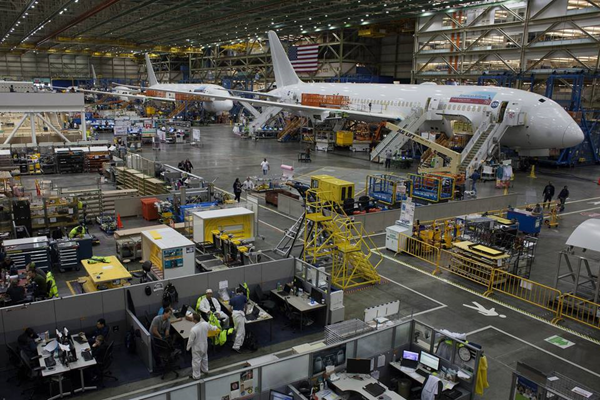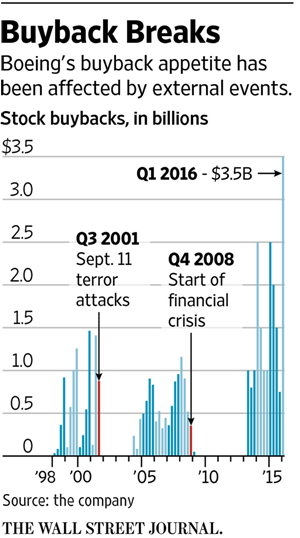|
THE
WALL STREET JOURNAL.
Business
Boeing’s Buyback Spending Makes Some Analysts Jittery
Plane maker’s plans raises concerns about cash flow for future
buybacks and R&D
|

Boeing, the world’s largest plane
maker, ended the first quarter with $7.9 billion in cash.
PHOTO: DAVID RYDER/BLOOMBERG NEWS |
By
Jon Ostrower
May 10, 2016 6:41 p.m. ET
Boeing
Co., the world’s biggest plane maker by deliveries, has spent $19
billion buying back its own stock over the past three years, a
spending spree that worries analysts who think the airplane-building
cycle may be near its peak.
The plane maker has been
directing almost all of its free cash back to shareholders, boosting
buybacks and dividends with the proceeds from record deliveries of its
passenger jets.
While many investors like
having excess cash
returned via buybacks, some
Boeing analysts worry the company is unwisely borrowing from the
future. The worry is what will happen to cash flow if sales fall from
their current very high levels.
Some analysts and
investors watching Boeing’s plans are jittery about the path for cash
flows to keep rising through the end of the decade to pay for buybacks
and research and development.
“The upward trajectory on
cash runs out next year,” said Robert Stallard, managing director at
RBC Capital Markets. He said Boeing should be preserving its cash,
citing a coming cut in the production of its profitable 777 jet and
the billions of dollars Boeing and rival
Airbus Group SE
spent to right their recent jetliner
programs.
A Boeing spokesman said
that “the strong core operating performance across our business
continues to generate significant cash flow and financial strength.”
He said that strength, combined with a healthy growth outlook,
provides the company with a foundation to continue its balanced cash
deployment strategy where it can invest in “innovative products,
technology and delivering returns to shareholders.”
Boeing ended the first
quarter with $7.9 billion in cash and forecasts approximately $10
billion in operating cash flow in 2016, and signals it expects that to
climb through the remainder of the decade. It had revenue of $96.1
billion in 2015.
The company said both its
capital expenditures and research and development spending is up in
2016 and its production increases are plotted through the end of the
decade. It anticipates returning an additional $10.5 billion over the
next two years or so.
Boeing’s
plans to cut head count, increase
output and the production of a more profitable mix of planes can lead
to a bigger cash benefit, according to Cai von Rumohr, analyst at
Cowen & Co.
The plane maker moved its
buybacks into overdrive in the first quarter, spending a record $3.5
billion to repurchase 26.8 million shares.
Some investors and
analysts say that without a better place to invest free cash—such as a
big acquisition or new airplane project—and a slate of development
programs progressing smoothly, returning the cash to shareholders is
the best way to maintain an efficient balance sheet. Buybacks have
sharply increased among
many publicly traded companies,
reducing the number of available shares ultimately with the goal of
increasing the value of each share.
Boeing on Wednesday will
host its annual investor forum in Seattle to provide Wall Street with
insight into the company’s longer-term outlook, including its closely
watched cash flow.
Some analysts have also
pointed to how Boeing is adding to its overall cash pile. As its
factories pump out jetliners faster than ever, Boeing receives
progress payments during production from buyers to build their jets.
According to one leasing
company executive, Boeing during recent years has traded earlier cash
payments for concessions like improved pricing or making changes to
their orders.
Boeing has also asked its most stalwart
customers, and biggest buyers, for earlier payments.
United Continental Holdings Inc.
accelerated roughly $330 million to
Boeing during the fourth quarter of 2015, according to regulatory
filings.
Alaska Air Group Inc.
also said it had provided $72 million in
earlier advances to the plane maker in the fourth quarter of 2015.
Moving the payments
earlier “was a favor to one of our manufacturers and it does help us
out,” said Mark Eliasen, Alaska’s vice president of Finance and
Treasurer in January. A United spokesman said the advances are part of
“the normal course of business.”
A Boeing spokesman said
the timing of cash payments shifts from quarter to quarter and it
expects its advances to continue rising with output. “We partner with
our customers and suppliers to work through quarterly cash flow
volatility,” the spokesman said. “But it’s important to note these
actions go both ways.”
‘We partner with our
customers and suppliers to work through quarterly cash flow
volatility.’
—spokesman for Boeing
The plane maker is
confident it can book some cash early because its big order book will
keep the liquidity flowing.
Boeing Chief Executive
Dennis Muilenburg said last week that order cancellations and changes
were running far behind historical norms. Even if cancellations
spiked, said Mr. Muilenburg, “We’ve in fact designed our plans to
envelope those historical averages.”
The company is also
heading into a crucial period that could require significant research
and development spending, which could include moving ahead with plans
for an all-new jetliner to reverse market share losses to Airbus.
The advanced Dreamliner,
however, is Boeing’s ticket to a cash-rich future. Boeing has racked
up deferred costs of nearly $29 billion building more than 400 of its
787 Dreamliners. The company’s cash generation strategy is rooted in
recovering those costs, and then some.
To fill that hole, Boeing
projected at the end of the first quarter it would need an average
profit of $36 million on each of the next 662 planes it has on order.
The company says it won’t generate positive cash on each 787 delivery
until late this year.
Bank of America
forecasts a $14 billion shortfall, but
the company reiterates its plans are on track.
Write to
Jon Ostrower at
jon.ostrower@wsj.com
|

